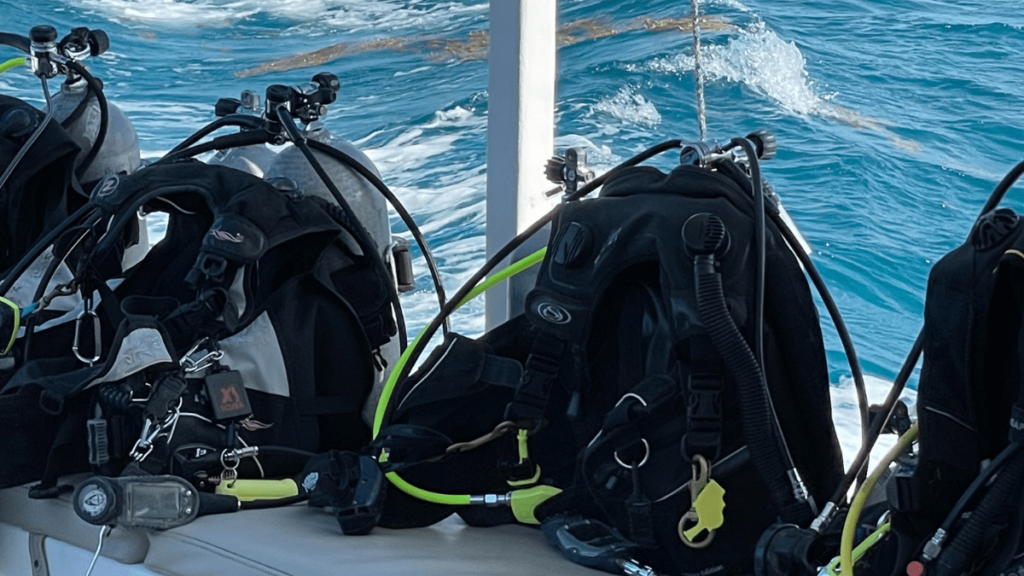Diving with sharks is a dream come true for many. It’s not every day you get a chance to be so close to such magnificent creatures, and though many dives may shy away from letting people get so close to potentially dangerous animals, there are still plenty of tour operators out there happy to get people close to the action.
Even on dives that are not explicitly listed as “shark diving” tours, you may well encounter them anyway – sharks are an inevitable and ubiquitous part of the ocean in many places!
Whenever diving with sharks – or even diving in an area you may encounter them – it’s important to remember that they are wild animals, and they do have the ability to hurt or seriously injure you if you provoke them.
It’s, therefore, important to bear in mind a number of safety tips that will ensure you come through unscathed.
Let’s take a look at the eight most important safety tips to keep in mind when diving with sharks.
Don’t Wear Shiny Stuff

When diving with sharks, probably the most important thing you can do is ensure that the shark doesn’t associate you with prey.
One thing that attracts sharks to prey is shiny, glittery scales – the light reflecting off fish scales helps sharks identify said fish and helps them zero in on the hapless animal.
This means things like jewelry, watches, or anything else that reflects light, you could cause the shark to mistake you for prey and close in for a bite. Ditch the earrings and the watch, and keep it simple.
Don’t Wear Colorful Clothing
Sharks are colorblind, so you’re probably wondering just why it matters what color clothes you wear. The reason for this is pretty simple – sharks may be colorblind, but they can distinguish between contrasts.
And there’s a pretty big contrast between a dull-colored seabed and, say, a neon-pink wetsuit. That contrast may get them interested enough to come over and investigate you.
Read Up On Shark Behavior
Before you get in the water with sharks, it’s a very good idea to read about their typical behavior for them – how they react when curious, how to tell if they’re being aggressive or hostile, and how to read their body language.
This serves two purposes. Firstly, if the shark is being aggressive for some reason, you may know how to defuse the situation.
Secondly, it demystifies the shark and makes sure that you don’t misinterpret its actions. This also makes it less likely that you’ll panic because you don’t understand what the shark is doing – which may serve to further excite the animal.
Move Slowly And Cautiously

That panicked behavior we talked about above? That’s generally the exact wrong thing to do with sharks.
Panicked creatures move quickly and erratically, drawing a lot of attention and putting sharks in mind of distressed fish – another prey object.
Keep it slow, calm, and cautious, then. Don’t make sudden movements, and don’t move around too quickly.
If you’re near the bottom, this can stir up the seabed, which can reduce visibility, and further increases the chances that you’re mistaken for prey.
Breathe Steadily
When you encounter a shark in the wild, it can be an exhilarating experience – but it can also be frightening for many people.
This can lead to hyperventilation or even holding your breath. The former isn’t great when you’re 20 meters under the water, and the latter can be disastrous.
Neither of these has anything to do with the sharks themselves but with your ability to dive. If you hyperventilate, you’re going to burn through your oxygen, and you’ll need to surface faster.
If you hold your breath and drift up (which will happen because you’ll be more buoyant), you run the risk of damaging your lungs.
Stay With Your Diving Buddy
Whenever you go diving, you’ll be assigned a diving buddy. There are many reasons for this, but the major ones all have to do with safety – it’s important that you have someone you’re keeping an eye on, and that’s keeping an eye on you in turn.
When it comes to shark diving, this is doubly important. Sharks are less likely to bother larger groups of people, and if there are two of you instead of just one, a shark probably isn’t going to get too close. Your buddy can also help to watch behind you, and vice versa.
Avoid Diving At Dawn Or Dusk
Most shark species are crepuscular, which means they’re most active at dawn and dusk. This also means they’re actively searching for prey at these times, which increases the chances that they’ll see you as prey. It’s not a good idea, then, to be diving at these times.
The best time to dive is around midday when the sun is high in the sky. Sharks are more cautious than usual at these times and are unlikely to approach strangers in their habitat.
Keep Your Distance

Last but by no means least: keep your distance from the sharks. Most accidents that take place with large marine animals are 100% down to the diver not giving them their space or even being so foolhardy as to try to touch them.
Sharks can be skittish creatures, or they can simply perceive something that’s getting too close as a threat.
As wild animals, their first instinct may be to flee – but it can just as easily be to attack out of self-defense.
And as creatures with extremely sharp teeth and powerful bites (yes, even the smaller ones), they can do some real damage.
Bottom line: respect not only sharks but all marine life, and keep your distance. And never touch anything.
The Key to Safely Diving With Sharks? Keep Your Distance!
Though diving with sharks can strike many people as a daunting experience, the fact is that sharks are incredibly unlikely to approach you – and the chances of being attacked are astronomically low.
By far, the most likely reaction of any shark to visitors into their habitat is going to be caution – or, at most, mild curiosity.
Bear this in mind and follow the tips laid out in this article, and you’ll be completely fine!
